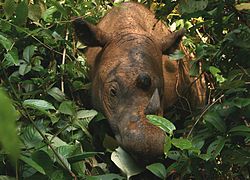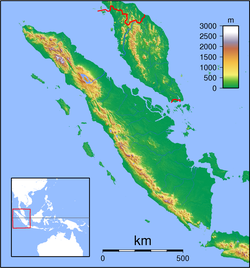Way Kambas National Park
From Wikipedia, the free encyclopedia
| Way Kambas National Park | |
|---|---|
IUCN Category II (National Park) | |
 Sumatran Rhino in the Way Kambas Sanctuary | |
| Location in Sumatra | |
| Location | Way Kanan Regency, Lampung, Sumatra, Indonesia |
| Nearest city | Bandar Lampung |
| Coordinates | 4°55′S 105°45′E / 4.917°S 105.75°ECoordinates: 4°55′S 105°45′E / 4.917°S 105.75°E |
| Area | 1,300 km²[1] |
| Established | 1989[1] |
| Visitors | 2,553 (in 2007[2]) |
| Governing body | Ministry of Forestry |
It consists of swamp forest and lowland rain forest, mostly of secondary growth as result of extensive logging in the 1960s and 1970s.[3] Despite decreasing populations, the park still has a few critically endangered Sumatran Tigers, Sumatran Elephants and Sumatran Rhinoceroses. It also provides excellent birdwatching,[4] with the rare White-winged Wood Duck among the over 400 species present in the park.
Threats to the park are posed by poaching and habitat loss due to illegal logging. Conservation efforts include patrolling and the establishment of the Sumatran Rhino Sanctuary and the Elephant Conservation Centre.
Contents |
[edit] Flora and fauna
Plant species include Avicennia marina, Sonneratia species, Nypa fruticans, Melaleuca leucadendra, Syzygium polyanthum, Pandanus species, Schima wallichii, Shorea species, Dipterocarpus gracilis, and Gonystylus bancanus.[5] The sandy shores of the park are dominated by Casuarina equisetifolia.[3]The park has 50 species of mammal many of them critically endangered. There are about 20 Sumatran Rhinoceros in the area,[6] down from around 40 in the 1990s.[7] The number of Sumatran Elephants in the park was estimated to 180 in 2005.[8] The population of Sumatran tigers has declined from 36-40 in 2000 to less than 30.[9] Other mammals in the park are the Malayan tapir, Dhole (Cuon alpinus sumatrensis) and Siamang (Hylobates syndactylus syndactylus).[5]
About half of the bird species are inhabiting the coastal swamps, including mangroves, riverine forest, freshwater and peat swamp forest, and the marshes of the area. The park is one of the last strongholds of the White-winged Wood Duck, with a population between 24-38 birds left, the largest in Sumatra.[3] Among the other 405 species of bird recorded in the park, are the Storm's Stork, Woolly-necked Stork, Lesser Adjutant, Crested Fireback, Great Argus and Oriental Darter.[5]
Among the reptiles, the endangered False gharial crocodile is found in the coastal swamps.[3]
[edit] Threats and conservation
Way Kambas has been established as game reserve by the Dutch administration in 1937, but only in 1989 has been declared a National Park.[3]Significant encroachment has occurred along the southern boundary of the park by villagers claiming traditional land rights. Roads and trails into the park are starting points for illegal logging that penetrates into the interior of the park.[7] This resulted in the forest coverage declining to 60% of the park. In 2009-10 an area of 6,000 hectares which was occupied by squatters for decades has been evicted.[10]
Wells left behind by relocated communities in 1984, have proven to be deadly traps for the animals, including baby elephants, rhinos and tigers. In a conservation effort between 2008 and 2010 around 2,000 wells have been closed.[11]
Poaching has been a significant threat,[6] often involving soldiers and in a 2002 case even high-ranked military.[6] In recent years poaching is reported to be more under control, with no cases of rhinoceros poaching,[6] and no cases of tiger poaching reported between 2004 and 2011.[9]
In early 2011 the Ministry of Forestry announced the allocation of funds to establish a rare flora and fauna rehabilitation centre in the park.[10]




 02.26
02.26
 virizblogg
virizblogg











0 komentar:
Posting Komentar